
The long sunny days of summer can be perfect to get active with your pooch. Most of the dog parents take their dog out for swimming or on road trips during summer. If you decide to indulge in any of these activities during summer, it is important for you foresee the possibility of heatstroke.
Both humans and dogs can get heatstroke, but while the former knows what to do exactly, the latter might need assistance. This is where as a dog parent it is always recommended that you are aware of the symptoms of heatstroke in dogs.
Heatstroke Symptoms
The environment is the crucial factors that set up the possibility of heatstroke in your dog. Any dog which is confined in a small space or in humid conditions, without access to fresh and cool air is susceptible to heatstroke.
Some of the dog breeds like brachycephalic dog breeds are more vulnerable to heatstroke than the other breeds. The anatomical deformity in brachycephalic dogs is the main contributing factors that lead to heatstroke.
Earlier detection of heatstroke in dogs can be crucial in bringing the issue under control without causing much havoc.
There are some earlier symptoms of heatstroke in dogs are that are always worth keeping an eye out for, especially during summer days.
- Excessive panting
- Excessive drooling
- High body temperature
- Abnormal or white gums
Progressive stage of heatstroke can be a tad worse and difficult to bring under control. Some of the progressive symptoms of dog heatstroke are given below:
- Thick, tarry stool
- Shock
- Kindy failure
- Breathing distress and stoppage of heart
- Vomiting blood
- Muscle tremors
- Unconsciousness
If you feel that your dog is exhibiting any of these serious heatstroke symptoms, it is ideal to take him to a veterinarian without wasting time. Most of the serious symptoms of a dog heatstroke are hard to identify. A veterinarian needs to perform a detailed check-up to identify the exact condition to provide the appropriate treatment.
Causes
Some of the factors that can cause heatstroke in dogs are as follows:
- Extremely hot and humid climatic conditions
- Allergens like pollen which can inhibit respiration
- Poisoning from substances like slug, snail bait etc.
- Excessive workout
- Any disease that can directly or indirectly enhance the possibility of causing hyperthermia
First aid
Treating your dog immediately for any heatstroke symptom is important and can even help you save the life of your pooch.
Cool him down: Always remember to not try to cool your pooch down quickly. Instead, try to bring down the body temperature gradually. The best way to do this is by wrapping a wet towel around his body.
Rest him: Once you bath him, get him to rest in a cool environment with lots of fresh air. Try to regulate airflow over his coat using a fan or an air conditioner.
Hydrate him: offer him water and ensure that he doesn’t consume it too quickly. Therefore, it is wise to give him water in small portions.
As a pet parent, it is important that you try everything to prevent your dog getting heatstroke. Always carry plenty of fresh water with you when you wish to go out with your dog and do not over exercise him, especially on hot and humid days. Even if you go out for a walk during summer, ensure that you give him frequent breaks.
